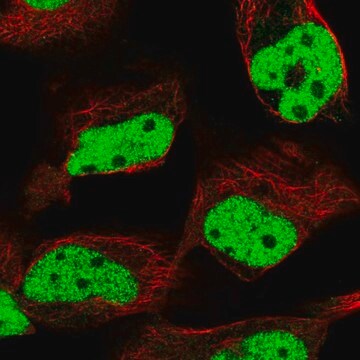M8320
Anti-MLH1 (N-terminal) antibody produced in rabbit
~1 mg/mL, affinity isolated antibody, buffered aqueous solution
Synonim(y):
Anti-COCA2, Anti-FCC2, Anti-HNPCC, Anti-MGC5172
About This Item
Polecane produkty
pochodzenie biologiczne
rabbit
białko sprzężone
unconjugated
forma przeciwciała
affinity isolated antibody
rodzaj przeciwciała
primary antibodies
klon
polyclonal
Postać
buffered aqueous solution
masa cząsteczkowa
antigen 80-85 kDa
reaktywność gatunkowa
rat, human, mouse
opakowanie
antibody small pack of 25 μL
stężenie
~1 mg/mL
metody
immunocytochemistry: 2.5-5 μg/mL using MCF7 cells fixed with paraformaldehyde-Triton
immunoprecipitation (IP): 5-10 μg using Jurkat cell lysates
western blot: 0.5-1 μg/mL using Jurkat cell lysates
numer dostępu UniProt
Warunki transportu
dry ice
temp. przechowywania
−20°C
docelowa modyfikacja potranslacyjna
unmodified
informacje o genach
human ... MLH1(4292)
mouse ... Mlh1(17350)
rat ... Mlh1(81685)
Opis ogólny
Immunogen
Zastosowanie
- Anti-MLH1 (N-terminal) antibody produced in rabbit has been used in:
- immunoblotting
- immunoprecipitation
- immunocytochemistry
Działania biochem./fizjol.
Opis wartości docelowych
Postać fizyczna
Oświadczenie o zrzeczeniu się odpowiedzialności
Not finding the right product?
Try our Narzędzie selektora produktów.
produkt powiązany
Kod klasy składowania
10 - Combustible liquids
Klasa zagrożenia wodnego (WGK)
WGK 3
Temperatura zapłonu (°F)
Not applicable
Temperatura zapłonu (°C)
Not applicable
Środki ochrony indywidualnej
Eyeshields, Gloves, multi-purpose combination respirator cartridge (US)
Certyfikaty analizy (CoA)
Poszukaj Certyfikaty analizy (CoA), wpisując numer partii/serii produktów. Numery serii i partii można znaleźć na etykiecie produktu po słowach „seria” lub „partia”.
Masz już ten produkt?
Dokumenty związane z niedawno zakupionymi produktami zostały zamieszczone w Bibliotece dokumentów.
Nasz zespół naukowców ma doświadczenie we wszystkich obszarach badań, w tym w naukach przyrodniczych, materiałoznawstwie, syntezie chemicznej, chromatografii, analityce i wielu innych dziedzinach.
Skontaktuj się z zespołem ds. pomocy technicznej







